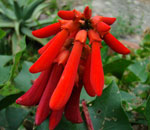Erythrina humeana
Dwarf Coral-tree; Kleinkoraalboom (Afrikaans);
umSinsana
(Siswati & Zulu); Mokhupye (North Sotho)
Article by
Geoff Nichols
Having just written
about the ultimate succulent
tree, I think it is time to deal with the “mini baobab” at the other
end
of the spectrum - Dwarf Coral-tree. This is the smallest of our local
species
making it a useful accent plant for a small and sunny garden. The Dwarf
Coral-tree
is deciduous making it a difficult plant to find in the veld in the
winter
time when only a few dry-looking twigs show above the ground. The plant
produces
a large underground stem that is known as a ligno-tuber in other words
a
wooden tuber. This is a mechanism employed by the plant to protect
itself
from fire. These lingo-tubers can get really big especially in sandy
soils
where the root can expand at will. I have seen roots that are larger
than
the thigh and legs of a sumo wrestler.
This
species grows usually in grassland to bushveld areas that are
prone to
periodic veldfires.
|

|
E. humeana grows from the Eastern Cape northwards along the coastal
belt
up into Mozambique. In KZN it moves up into the frost belt of the
Midlands
but really only survives in amongst rocks where it gets protected form
both
fire and frost. The picture of the one plant is at Caversham that is
prone
to severe frost. Another short underground stemmed species the
Ploughbreaker
– Erythrina zeyheri takes over in the highveld areas of Southern Africa.
The leaf shape is very distinctive with its tri-foliate shape. The
plants that originate from southern and central KwaZulu-Natal have much
broader leaflets
without a long tapering tip compared with the narrow bladed long-leafed
tips
of plants that live in the drier warmer parts of Zululand.
The leaves and the bright red flowers produced in the summer months are
more upright in their presentation making it a very good accent plant
in
a bed of other lower growing plants. I always try to plant at least
four
plants in a grouping to make a good show. Plants are relatively scarce
in
the horticultural industry and quickly get snapped up by gardeners.
The scarlet flowers jump out of the relatively calm colour of the
surrounding
veld.
As in the other species of Coral Tree the pollination agents are birds
and again the sunbirds like the Black, Scarlet-chested, Grey,
White-bellied and even the shorter beaked Collared excel.
I've had this plant flowering from seed in its third growing season.
The hard coated seeds are red and need to have the coating nicked or
scarified if you want them to germinate quickly. My method is to soak
the scarified seeds overnight in a cup of water and sow only the seeds
that have begun to
swell. Once sown the seeds germinate in a few days and the swollen
underground stem base begins to develop within the first growing
season.
